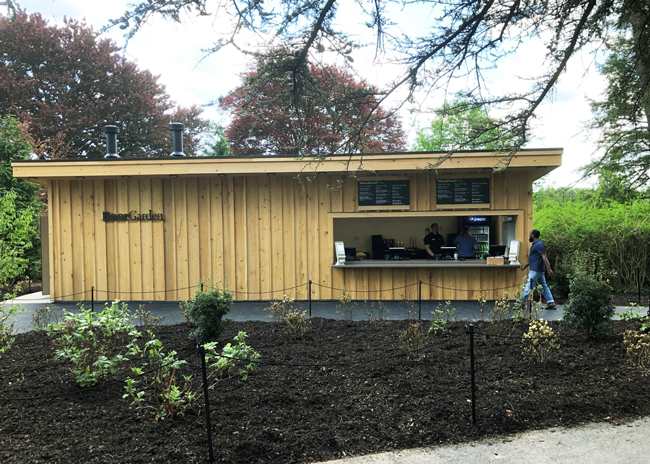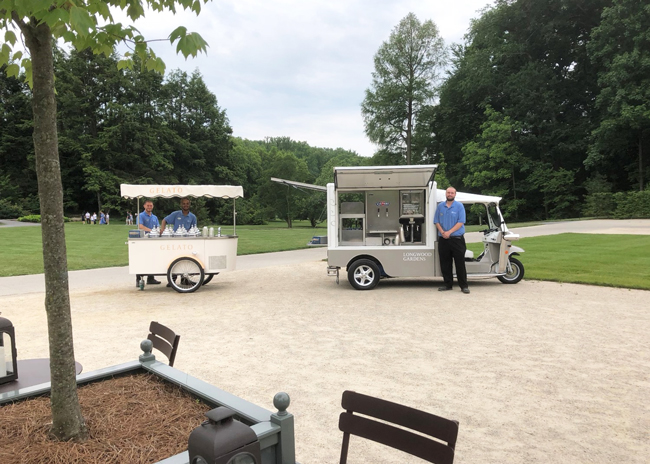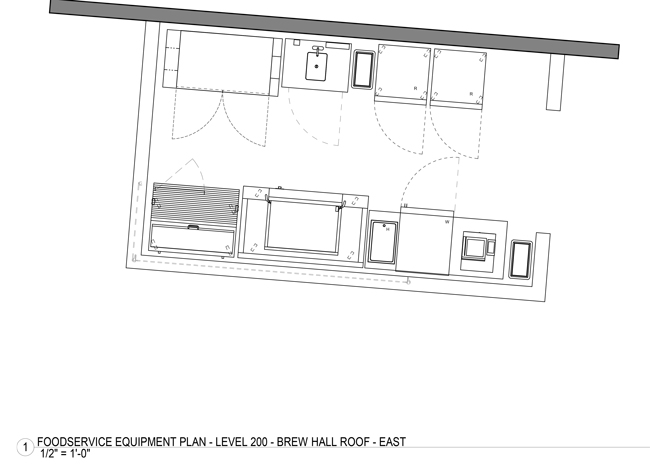Some dining adjustments made to cope with COVID-19 may be abandoned once public life returns to normal, but others will become permanent fixtures in American lifestyles. One of the habits with staying power: three-season outdoor dining.
 Indoor cooking pairs with fresh-air dining at Longwood Gardens botanical gardens in suburban Philadelphia. YuiDesign worked with foodservice concessions provider Restaurant Associates to construct two free-standing concessions buildings around an existing beer garden. One features a grill with burgers as the primary menu item and the other offers pizza cooked in two wood-burning pizza ovens.According to the National Restaurant Association’s newly released “State of the Restaurant Industry 2021,” more than half of full-service restaurants devoted resources to launching or expanding outdoor dining options in 2020, including 48% of family-dining, 56% of casual-dining and 62% of fine-dining establishments. And it wasn’t just FSRs: 37% of fast-casuals and 30% of coffee and snack places also invested. Some restaurants took advantage of cities’ loosened rules on sidewalk or street dining. And as cool weather approached in the fall, some rushed to erect tents or shelters to please the 70% of consumers who said they’d be up for dining in a temperature-controlled outdoor environment.
Indoor cooking pairs with fresh-air dining at Longwood Gardens botanical gardens in suburban Philadelphia. YuiDesign worked with foodservice concessions provider Restaurant Associates to construct two free-standing concessions buildings around an existing beer garden. One features a grill with burgers as the primary menu item and the other offers pizza cooked in two wood-burning pizza ovens.According to the National Restaurant Association’s newly released “State of the Restaurant Industry 2021,” more than half of full-service restaurants devoted resources to launching or expanding outdoor dining options in 2020, including 48% of family-dining, 56% of casual-dining and 62% of fine-dining establishments. And it wasn’t just FSRs: 37% of fast-casuals and 30% of coffee and snack places also invested. Some restaurants took advantage of cities’ loosened rules on sidewalk or street dining. And as cool weather approached in the fall, some rushed to erect tents or shelters to please the 70% of consumers who said they’d be up for dining in a temperature-controlled outdoor environment.
“The consumer expectation has, I think, changed forever,” says design consultant Jimi Yui, FCSI, of Maryland-based YuiDesign. “Major cities are starting to look like European cities with outdoor cafes all over. They’ve created an urban experience that’s actually pretty nice. And suburban places have the virtue of having real estate where they can create all kinds of options — installing garage doors for an indoor-outdoor experience, or adding a shed or tent in the parking lot.”
The long-term trend toward eating al fresco predated the pandemic, points out Sean Callnin, FCSI, executive principal at Colorado-based Ricca Design Studios. “It’s because of the emphasis on wellness, the desire for fresh air and light,” he says. “I’ve worked on all kinds of outdoor dining environments, especially in California and other warm environments. Everybody’s looking to do something — resorts, hotels, even corporate campuses really like to have outdoor environments for their staff.”
Callnin is quick to add that most of those arrangements are simply fresh-air seating for guests or employees to eat meals that were prepared in an adjacent restaurant or food hall. While foodservice operators and facilities may be open to the idea of adding outdoor cooking to an outdoor dining room to enhance the customer experience, it’s complicated.
 Mobile concessions around Longwood Gardens — like the ice cream and gelato carts and a beverage- dispensing truck — round out the offerings around the botanical gardens. Photos courtesy Restaurant Associates
Mobile concessions around Longwood Gardens — like the ice cream and gelato carts and a beverage- dispensing truck — round out the offerings around the botanical gardens. Photos courtesy Restaurant Associates
Outdoor Cooking Rules
Health department rules vary greatly from one jurisdiction to another, but “the basic thing is that you can’t just have a permanent outdoor kitchen,” Callnin says. “Everything has to be mobile — even a sink. You can’t prepare or assemble food outside. You can grill or barbecue, but under most codes, the food has to come back into the kitchen to be assembled and served.”
Outdoor cooking is not allowed on a daily basis, says Russell Stilwell, FCSI, founder and principal of Next Step Design, Annapolis, Md. “You can do mobile stuff that you don’t have to show on the plan, and [the health department] won’t call a foul,” he explains. “You can put up a whole kitchen in a tent outside, with a grill and refrigeration and mobile bars on casters, just like what an off-premises caterer would set up. You can have a Friday night burger night and grill outside. But it’s not something they want to see 24/7.”
Additionally, food safety inspectors are extremely concerned about any potential contact between food and nature’s critters — rodents, birds, flies. For that reason, permanent food and beverage areas open to the outdoors must be covered and protected, explains Stilwell. “We do a lot of outdoor bars,” he says. “They all have to be tightly covered. There was a hotel in Miami that did a bootleg outdoor kitchen, completely open to the elements, and the health department shut it down; they had to build an enclosure with sliding windows.”
Equipment like grills, griddles, fryers or dome pizza ovens rolled out for for temporary use can operate without grease hoods. “If you just have a grill, you can exhaust to the atmosphere. You can live with that, but you’re completely subject to the weather conditions,” says Yui.
Health departments want to see kitchens fully enclosed, Callnin cautions. “No open garage doors, no doors propped open,” he explains. “They require fly fans on doors to the exterior. And some jurisdictions are very specific about pass-through windows to the outside; the maximum size equates to 36 inches by 12 inches — you can make it square — with automatic sliding doors, not manual-closure doors.”
 As part of a rebranding of the Harrah’s Gulf Coast resort and casino in Biloxi, Miss., Rippe Associates oversaw construction of a permanent outdoor pool bar with taps and bottled beers. Due to the long distance to the kitchens, a walk-in cooler was provided on the outdoor patio. The area was enclosed to contain an icemaker and the beer system for the bar. Images courtesy Rippe Associates
As part of a rebranding of the Harrah’s Gulf Coast resort and casino in Biloxi, Miss., Rippe Associates oversaw construction of a permanent outdoor pool bar with taps and bottled beers. Due to the long distance to the kitchens, a walk-in cooler was provided on the outdoor patio. The area was enclosed to contain an icemaker and the beer system for the bar. Images courtesy Rippe Associates
Successful Installations: Working with Outdoor Cooking Rules
Callnin is part of a team working on a new rooftop dining area overlooking a large tech company’s Silicon Valley campus. The company “wanted a rooftop barbecue grill area to take advantage of the beautiful views,” he says.
Callnin says his team “worked with the client and the architect to push the boundaries of what we can do with mobile equipment.” The setup includes a full indoor back kitchen plus mobile equipment that staff can set up daily and then return it to the kitchen after a two-hour service period. Although staff cook meat outdoors in view of diners, they return it to the back-of-the-house area and put the protein into pans, then place it on the outdoor counter for a short service period.
The design team interacted closely with the local health department. “They wanted to know the exact times the food was going to be served, how long it was going to be out. We had to submit HACCP plans,” Callnin explains. “In the end, we scaled back on what was fixed outdoors, used more countertop equipment, chafing dishes and more of a catering format along with mobile heated and refrigerated cabinets on casters.”
 At the new Allianz Field soccer stadium in St. Paul, Minn., Rippe Associates designed a rooftop dining venue featuring an outdoor cooking area surrounded by low masonry walls to separate the space from guests. Staff bring food from a main kitchen, where it is held in mobile warmers and refrigerators prior to finishing. Image courtesy Rippe AssociatesMinnesota-based Rippe Associates also worked on a complex rooftop project. The Rippe team included senior project manager Jill Anderson, FCSI; company president Steve Carlson, FCSI; and project coordinator Zach Swanson. The project was a plexiglass-walled, shaded dining area above a brewpub at Allianz Field, a newly constructed professional soccer stadium in St. Paul, Minn. The roll-out, roll-in mobile equipment specified for this space included a high-end gas grill and cold prep tables, all placed along a back wall. The setup was approved by the local health department with the proviso that meat could not be cooked from a raw state. “What we ended up doing was finishing and rethermalizing partially cooked burgers on-site,” Anderson explains. To give the menu a custom touch, staff add garnishes to order from cold wells in the prep tables. Note: The lids of the cold wells are not fully removable, ensuring that the wells are open to the air for as little time as possible.
At the new Allianz Field soccer stadium in St. Paul, Minn., Rippe Associates designed a rooftop dining venue featuring an outdoor cooking area surrounded by low masonry walls to separate the space from guests. Staff bring food from a main kitchen, where it is held in mobile warmers and refrigerators prior to finishing. Image courtesy Rippe AssociatesMinnesota-based Rippe Associates also worked on a complex rooftop project. The Rippe team included senior project manager Jill Anderson, FCSI; company president Steve Carlson, FCSI; and project coordinator Zach Swanson. The project was a plexiglass-walled, shaded dining area above a brewpub at Allianz Field, a newly constructed professional soccer stadium in St. Paul, Minn. The roll-out, roll-in mobile equipment specified for this space included a high-end gas grill and cold prep tables, all placed along a back wall. The setup was approved by the local health department with the proviso that meat could not be cooked from a raw state. “What we ended up doing was finishing and rethermalizing partially cooked burgers on-site,” Anderson explains. To give the menu a custom touch, staff add garnishes to order from cold wells in the prep tables. Note: The lids of the cold wells are not fully removable, ensuring that the wells are open to the air for as little time as possible.
Sometimes an indoor kitchen with a walk-up window is the best solution. Working with foodservice contractor Restaurant Associates at Longwood Gardens, a botanical garden in southeastern Pennsylvania, YuiDesign created two stand-alone kitchen sheds for a beer garden: staff at one dispense pizzas flash-baked in a pair of wood-burning pizza ovens, and in the other they serve grilled meats. The kitchen structures represent the evolution of ad hoc outdoor foodservice that RA staff experimented with a few summers ago. “We had to go to the health department to get a special permit,” says Ken Warner, RA’s vice president of operations and former regional director at Longwood. “They said we could do outdoor cooking for three months if we had no outside prep, but if we wanted to cook outside permanently, we should build a true kitchen.”
It wasn’t too hard to sell the investment costs to management at Longwood, Warner says, because the 1,000-acre garden can attract as many as 15,000 to 20,000 guests a day in high season — and 7 out of 10 take a break during their visit to order food and beverages. Warner says that RA’s team engaged the health department before starting the design process “just to make sure we were doing everything exactly to their specs.”
Warner is convinced that for environments like Longwood Gardens, free-standing indoor kitchens are the best solution. “Our local health department and our own experience have shown us that keeping cooking indoors is the safest and best way to provide the highest-quality food products to the most people,” he says.
10 Tips for Outdoor Kitchens
-
Start with the menu. “Success in outdoor dining begins with compelling menus and recipes that speak to people who want the excitement of outdoor barbecuing and grilling, but in a safe way,” says Arlene Spiegel, FCSI, of New York-based Arlene Spiegel & Associates.
-
Have a plan if you want to do open-flame cooking. “Burning solid fuel — wood or coal — is definitely easy to do outside,” says Callnin. “But the fire marshal will want to know what you’re doing and how you’re handling it, and you get into a different code there than the health department code.” You won’t have a Type 1 hood over cooking equipment used outdoors, but the design team may still need to find a mechanical solution to divert smoke away from diners, whether it’s a chimney, flue or fan.
-
Consider using holding equipment instead of cooking. “Many health departments, building departments and fire departments really do not want open-flame cooking,” Spiegel notes. She suggests using electric grills or induction cooking. Or, she says, “Charring and flaming can be done indoors in the kitchen, and the food rolled out in fully enclosed holding units to be finished with some flair in front of guests. There’s so much mobile controlled-vapor heat-and-hold equipment that’s also ventless; you can wheel out all kinds of goodies — offer them from tableside carts.”
-
Incorporate a mobile hand sink. Even a sink is not generally allowed as a fixed installation outdoors, but mobile sinks with a self-contained water supply are a handy alternative. Make sure the drain for disposing of gray water, and the tap for refilling the unit, are closely adjacent to where the sink will be used, says Callnin.
-
Think about how to use outdoor counter surfaces. “Counters can be used for vendors to set up marketing materials, or as a beverage or champagne station,” suggests Callnin. “So you should really get into what they look like. If the counter will be used to serve food, you’ll need foodservice-grade sealed surfaces like certain types of stone, granite or marble. The best quality stainless also works, unless you’re near the coast and the salt air.”
-
The surface underfoot is important, too. “You need to follow the food code when doing outdoor flooring,” cautions Anderson. “We typically recommend quarry tile, but nonporous concrete would suffice.”
-
Efficient, sanitary service depends on a well-thought-out food ordering and delivery system. “People are still looking for safety first, so you have to make it easy to order food and get it from the kitchen to the plate,” Spiegel says. “What has been working well is mobile ordering through a QR code that guests scan on their phone from a menu pop tent on the table. The order goes wirelessly to the kitchen prep area, then gets put on a tray with a plate cover to be delivered by a server.” And Callnin says a recent Ricca stadium project is based on the Disneyland service model, with food cooked in indoor kitchens and dispensed via sliding windows to be eaten at an outdoor seating area. Customers begin at an ordering podium, where well-trained greeters help to manage the line and prevent crowding.
-
Make a detailed plan, then talk to the health department before proceeding. “The biggest challenge is the fact that the health codes don’t really address requirements for outdoor cooking and serving,” says Carlson. Because different people interpret the same code differently, and because there can be significant turnover among health department officials in the course of a project, written codes can’t really be relied on, he explains. “For these projects, you end up negotiating the requirements with the code officials,” he says, adding that discussions should happen after you research local codes and create a detailed plan for the menu and service style, but before investments have been made for infrastructure and equipment. And, he adds, “have a backup plan.” If the health department objects to something, “there might be other ideas that they would be fine with.”
-
A plan that involves a permanent structure calls for a building permit. “Even a roof supported by posts will require a permit,” says Yui. “And since everybody else is trying to do the same thing at the same time, that might not come for weeks.” Temporary structures in privately owned suburban parking lots and strip malls usually will not require permitting, he adds, so operators in those types of locations have more flexibility, as long as the landlord agrees.
-
Consider a food truck and/or mobile kitchen. Food trucks and enclosed mobile kitchens (fitted into trailers or shipping containers) offer ready-to-go alternatives for preparing and serving food to those dining outdoors. “You can install a kitchen inside a 20-foot container, and it will be completely temporary and moveable with a trailer hitch,” says Yui.



